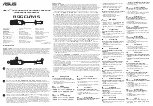
Shure Incorporated
7/10
Low-cut Filter
The low-cut filter reduces low frequency rumble caused by camera handling and other environmental factors by rolling off low
frequencies 170 Hz and below (12 dB per octave). To engage, slide the power switch to the low-cut filter (
) position.
Monitoring the Audio Signal
To listen to the audio while recording, connect a pair of headphones to the camera's headphone output. Use the camera's
headphone volume control to adjust the monitoring level. Do not use the gain switch on the VP83 to adjust the monitoring level.
Why Gain Settings are Important
Proper gain adjustment is necessary to achieve the best signal-to-noise ratio. When recording audio, the camera's preamp cir-
cuitry may introduce a small amount of noise that increases as the camera's preamp gain is raised, or when volume levels are
raised during post production.
How the VP83 improves performance:
The VP83 microphone has very low noise characteristics, which means that using
more gain from the microphone and less from the camera improves the signal-to-noise ratio and results in a cleaner audio sig-
nal.
Troubleshooting
Issue
Solution
Unit does not turn on
Replace batteries and make sure that the batteries are installed correctly.
Sound is distorted
Check that the audio cable is completely inserted into the camera.
Camera input gain may be set too high, resulting in clipping. Try lowering the gain. If the
camera's gain appears to be adjusted properly, try setting the gain switch to 0 or −10 dB.
If listening through headphones, check the connection or try using a different pair.
No sound
Make sure the microphone is on and that the audio cable is connected to the correct au-
dio input jack on the camera.
If the camera doesn't register a signal, try increasing the camera gain or setting the gain
switch to +20.
Specifications
Type
Electret Condenser
Содержание VP83
Страница 9: ...Shure Incorporated 9 10 ...




























